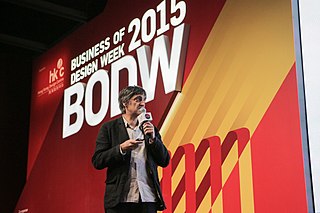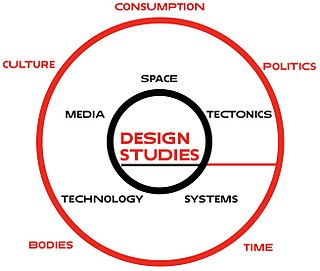
A design is a concept of or proposal for an object, a process, or a system. Design refers to something that is or has been intentionally created by a thinking agent, though it is sometimes used to refer to the nature of something - its design. The verb to design expresses the process of developing a design. In some cases, the direct construction of an object without an explicit prior plan may also be considered to be a design. A design is expected to have a purpose within a certain context, usually has to satisfy certain goals and constraints, and to take into account aesthetic, functional, economic, environmental or socio-political considerations. Typical examples of designs include architectural and engineering drawings, circuit diagrams, sewing patterns and less tangible artefacts such as business process models.
Participatory design is an approach to design attempting to actively involve all stakeholders in the design process to help ensure the result meets their needs and is usable. Participatory design is an approach which is focused on processes and procedures of design and is not a design style. The term is used in a variety of fields e.g. software design, urban design, architecture, landscape architecture, product design, sustainability, graphic design, planning, and health services development as a way of creating environments that are more responsive and appropriate to their inhabitants' and users' cultural, emotional, spiritual and practical needs. It is also one approach to placemaking.

In the arts, bricolage is the construction or creation of a work from a diverse range of things that happen to be available, or a work constructed using mixed media.
Design methods are procedures, techniques, aids, or tools for designing. They offer a number of different kinds of activities that a designer might use within an overall design process. Conventional procedures of design, such as drawing, can be regarded as design methods, but since the 1950s new procedures have been developed that are more usually grouped together under the name of "design methods". What design methods have in common is that they "are attempts to make public the hitherto private thinking of designers; to externalise the design process".

Lucy Suchman is Professor Emerita of Anthropology of Science and Technology in the Department of Sociology at Lancaster University, in the United Kingdom, also known for her work at Xerox PARC in the 1980s and 90s.

Mary Flanagan is an American artist, author, educator, and designer. She pioneered the field of game research with her ideas on critical play and has written several books. She is the founding director of the research laboratory and design studio Tiltfactor Lab and the CEO of the board game company Resonym. Flanagan's work as an artist has been shown around the world and won the Award of Distinction at Prix Ars Electronica in 2018.
Dunne & Raby is a London-based design studio established 1994.

Martí Guixé is a Spanish designer living in Barcelona and Berlin. He graduated in interior design from Elisava in Barcelona in 1985 and enrolled in an industrial design study program in Scuola Politecnica di Design di Milano in 1986. In 2001, as a statement against the limited scope of the traditional designer and to open new possibilities for the industry Guixé started an ex-designer movement, defining himself by the same name.
Immanent critique is a method of analyzing culture that identifies contradictions in society's rules and systems. Most importantly, it juxtaposes the ideals articulated by society against the inadequate realization of those ideals in society's institutions.

Objectified is a feature-length documentary film examining the role of everyday non-living objects and the people who design them, in our daily lives. The film is directed by Gary Hustwit. Objectified premiered at the South By Southwest Festival on March 14, 2009.
Systems-oriented design (SOD) uses system thinking in order to capture the complexity of systems addressed in design practice. The main mission of SOD is to build the designers' own interpretation and implementation of systems thinking. SOD aims at enabling systems thinking to fully benefit from design thinking and practice and design thinking and practice to fully benefit from systems thinking. SOD addresses design for human activity systems and can be applied to any kind of design problem ranging from product design and interaction design through architecture to decision-making processes and policy design.

Sascha Pohflepp was a German artist, designer, and writer whose work focused on the role of technology’s influence on the environment, often collaborating with scientists and other artists to explore this theme.

Critical making refers to the hands-on productive activities that link digital technologies to society. It was invented to bridge the gap between creative, physical, and conceptual exploration. The purpose of critical making resides in the learning extracted from the process of making rather than the experience derived from the finished output. The term "critical making" was popularized by Matt Ratto, an associate professor at the University of Toronto. Ratto describes one of the main goals of critical making as a way "to use material forms of engagement with technologies to supplement and extend critical reflection and, in doing so, to reconnect our lived experiences with technologies to social and conceptual critique." "Critical making", as defined by practitioners like Matt Ratto and Stephen Hockema, "is an elision of two typically disconnected modes of engagement in the world — "critical thinking," often considered as abstract, explicit, linguistically based, internal and cognitively individualistic; and "making," typically understood as tacit, embodied, external, and community-oriented."

Fiona Raby is a British artist and University Professor of Design and Social Inquiry at The New School. She served as professor of Industrial Design at the University of Applied Arts Vienna. She was also a member of the research and teaching staff at the Royal College of Art (RCA) from 1994 to 2015. She left to focus on her partnership with Dunne & Raby. Her work, in collaboration with partner Anthony Dunne, is part of the Museum of Modern Art's (MoMA) permanent collection.

Joep van Lieshout, is a Dutch artist and sculptor born in Ravenstein, Netherlands, and founder of Atelier Van Lieshout (AVL).
Design fiction is a design practice aiming at exploring and criticising possible futures by creating speculative, and often provocative, scenarios narrated through designed artifacts. It is a way to facilitate and foster debates, as explained by futurist Scott Smith: "... design fiction as a communication and social object creates interactions and dialogues around futures that were missing before. It helps make it real enough for people that you can have a meaningful conversation with".

Anthony Dunne is a critical designer, educator and founder of the art group Dunne and Raby. He runs the studio with his long term partner and collaborator Fiona Raby.

Design studies can refer to any design-oriented studies but is more formally an academic discipline or field of study that pursues, through both theoretical and practical modes of inquiry, a critical understanding of design practice and its effects in society.
Cathrine Maclennan Kramer is a Norwegian artist, designer and curator.
Speculative design is a design practice that is concerned with future design proposals of a critical nature. The term "speculative design" was popularised by Anthony Dunne and Fiona Raby as a subsidiary of critical design. The aim is not to present commercially-driven design proposals but to design proposals that identify and debate crucial issues that might happen in the future. Speculative design is concerned with future consequences and implications of the relationship between science, technology, and humans. It problematizes this relation by proposing provocative future design scenarios where technology and design implications are accentuated. These provocative design proposals are meant to trigger the debate about future challenges. Speculative design proposals might seem subversive and irreverent in nature as they are meant to initiate discussions not to be market products.












